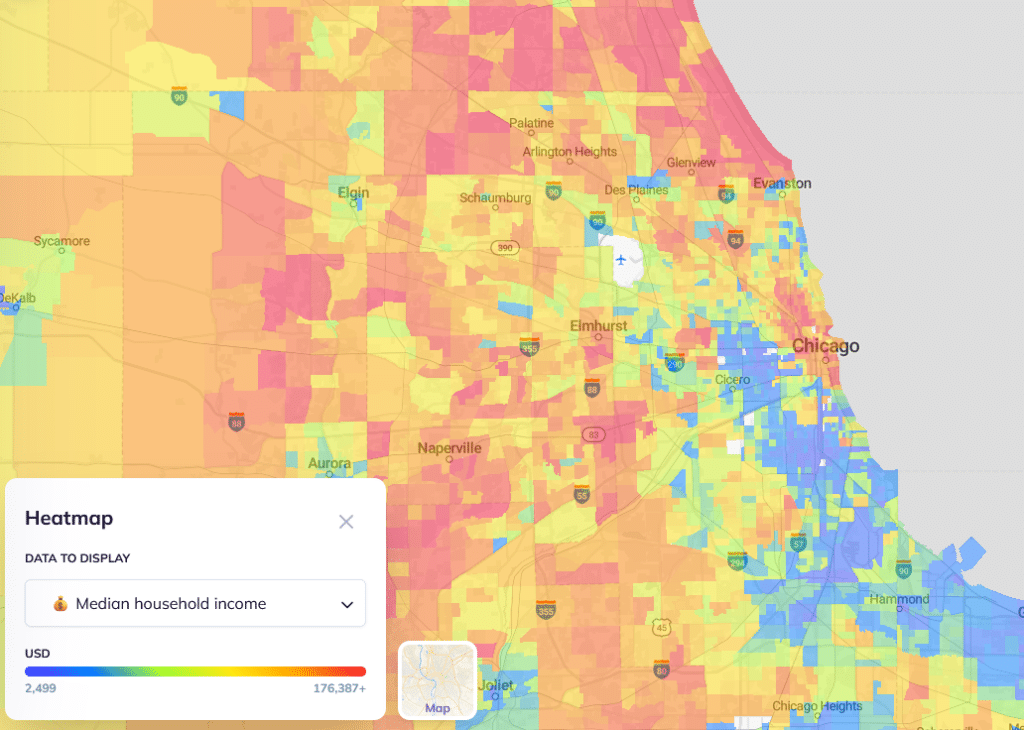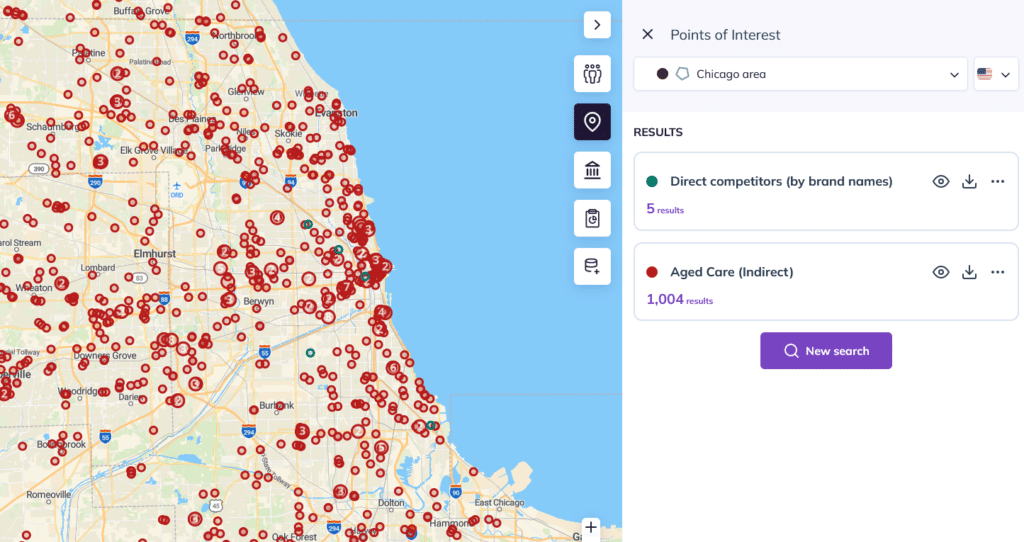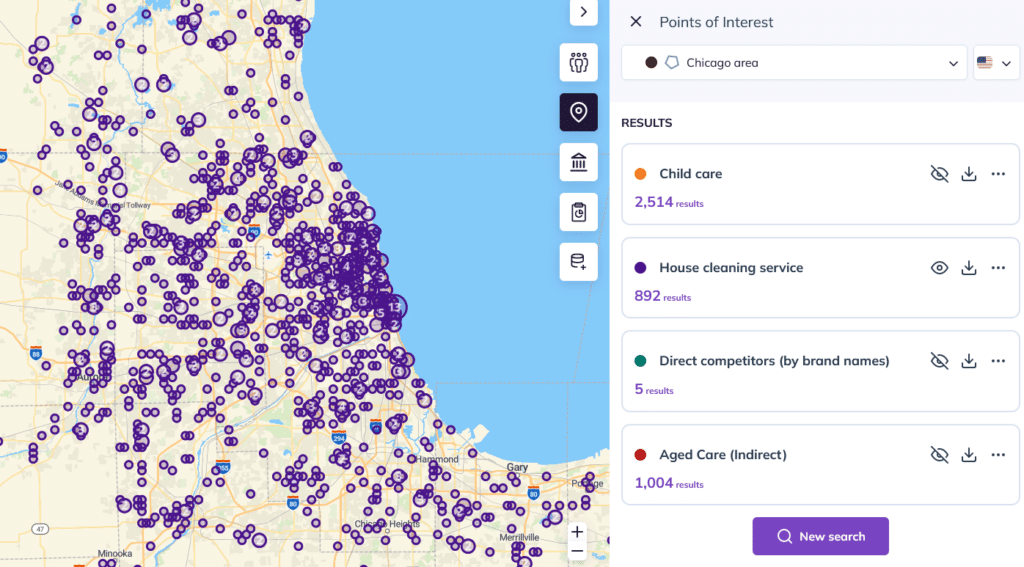Starting your journey into franchising is like diving into a pool of endless possibilities – super exciting, right?
But hey, let’s be real, with so many options out there, figuring out where to begin can be a bit overwhelming. No worries though! By diving into some smart analyses, you can quickly pinpoint the best spots to start, making sure you focus your energy on the most promising opportunities.
With these analytical goggles on, you’ll be able to see which paths hold the most promise, helping you direct your efforts and resources wisely right from the get-go.
So, here are 3 handy tips to get you started on exploring those new territories! 🌟
Before you dive in, make sure you’ve got your hands on a territory-mapping app packed with demographic insights and competitor data. It’s like having a secret weapon in your pocket, helping you scope out the landscape before you even take your first step.
1. Spotting success factor distribution
When gauging the potential of a particular area for your franchise, honing in on key success factors serves as your compass. These factors act as pivotal indicators, guiding your assessment of each territory’s viability. Therefore, it’s imperative to seek out regions where these success factors shine the brightest.
One nifty trick is to use heatmaps – they’re like X-ray vision for your franchise game plan. Heatmaps give you the lowdown on important stuff like:
- Median household income: A higher median income often signifies greater purchasing power and propensity to spend, making it a crucial factor in determining the economic health of a potential market.
- Population density: The concentration of residents within an area can provide insights into the potential customer base and competition. High population density areas may offer a larger pool of potential customers but also potentially stiffer competition.
- Median age: Understanding the age distribution within a community aids in tailoring your offerings to suit the demographics effectively. For instance, areas with a younger median age might be more receptive to trendy or tech-driven products and services.
And hey, those are just the tip of the iceberg – you can also check out things like class of workers, education or occupied housings.
By eyeballing these success factors on heatmaps, you’ll be able to sniff out the prime spots where everything lines up just right for your franchise goals. It’s like having a treasure map that leads straight to success! 🌟
Example:
Picture yourself as the mastermind behind “Golden Haven Care Concierge” – your go-to destination for top-notch home and senior care services. Tailored for those who value luxury and excellence in care, you’re eyeing up areas with plush median household incomes in the vicinity of Chicago.
So, you fire up that trusty heatmap and what do you see? Looks like Northbrook and the neighborhoods of Oak Park and Western Springs are shining bright like diamonds. They’re prime real estate for your franchise, offering the perfect blend of high-income households and potential clients hungry for top-tier care.
As for the south side of Chicago? Well, it’s not exactly ringing any bells for us. Time to focus your sights where the golden opportunities lie – up north!

Right, but how do I know my own criterias to evaluate?
Great question! We’ve wrote an entire blog post about it: Defining your territories’ winning criteria
2. Identifying competitors
Alright, let’s talk about sizing up the competition – it’s like doing a little detective work in the world of franchising. You see, when you spot competitors around, it’s a sign that there’s some action happening in the market. It’s like a litmus test – if there are players in the game, then there’s definitely something worth chasing.
But here’s the twist: sometimes, where you don’t see any competitors, it’s not necessarily a bad thing. It could mean there’s a goldmine waiting to be tapped, or maybe the market needs a little shake-up.
By identifying the top-performing competing brands and their geographical spread, you gain a strategic advantage. Analyzing their presence allows you to discern patterns and trends, shedding light on areas ripe for exploration or potential saturation. Moreover, studying their strategies and positioning can offer valuable lessons for your own franchise operations.
In essence, leveraging competitor mapping enables you to navigate the franchising landscape with precision, ensuring you make informed decisions and capitalize on opportunities that align with your business goals.
Example:
Alright, let’s zoom in on our brand, “Golden Haven Care Concierge.” We’re not just scouting for direct competitors – we’re casting our net wide to include all the players in the home care game.
Direct competitors? You betcha. We’re keeping an eye out for those luxury home care brands that offer similar premium services like us. They’re the ones playing in the same league, and it’s always good to know who your rivals are.
But hey, let’s not stop there. We’re also checking out the indirect competition – think all the other home care brands and services out there. From basic care to high-end options, we want to know who’s doing what and where they’re doing it.

On Smappen, you can use our Point of Interest search to spot your competitors. Follow our tutorial here
3. Identifying complementary businesses
Let’s talk about finding brands that vibe with yours – but without stepping on each other’s toes. We’re talking about complementary businesses (we can also called them “mirroring brands”) – they cater to the same crowd as you, but they’re not direct competitors. It’s like finding your franchise’s soulmates in the business world.
Start by thinking about brands that cater to your Ideal Customer Profile (ICP). They might not be in the same business as you, but they’re definitely speaking the same language to your target audience.
Can’t think of any off the top of your head? No sweat. Expand your search to include businesses that offer products or services that your ICP would be into. For example, if your franchise is all about healthy eats, check out fitness centers or yoga studios in the area. They’re not selling salads, but they’re definitely drawing in the same health-conscious crowd.
Now, here’s where it gets interesting. These complementary businesses aren’t just indicators of a hot market – they’re also bringing in foot traffic that you can rely on. It’s like having built-in customers just waiting to discover your franchise!
How to grow your franchise by partnering with complementary businesses? Follow the guide
Example:
Let’s put ourselves in the shoes of our senior care brand, “Golden Haven Care Concierge.” When we’re on the hunt for mirroring brands, we’re thinking about businesses that cater to families with 2 or 3 children and a healthy bank account. Why? Because they are often the ones juggling the care of their older loved ones while managing a busy household.
So, who are our potential mirroring brands? Picture this: premium child care services or top-notch house cleaning companies. They’re not in the senior care business, but they’re definitely speaking the same language to our target audience.

As with competitors, you can use points of interest research on Smappen to identify complementary businesses in your area.
You’ve nailed it! Spotting promising territories for your franchise involves considering three key factors:
- Demographic Population: Identifying areas with demographics that align with your target audience.
- Competitors: Analyzing the presence of competitors in the market to gauge its viability.
- Complementary businesses: Recognizing businesses that cater to a similar audience without directly competing with your offerings.
Now that you’ve got a handle on spotting those golden territories, the next step is evaluating and designing them to attract potential franchisees.
And guess what? That’s exactly what we are diving into in our ebook! 🚀

